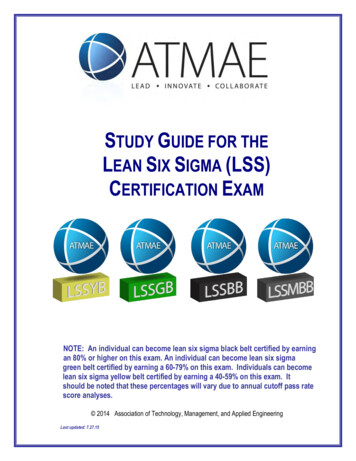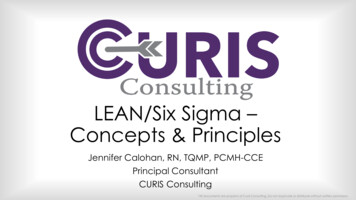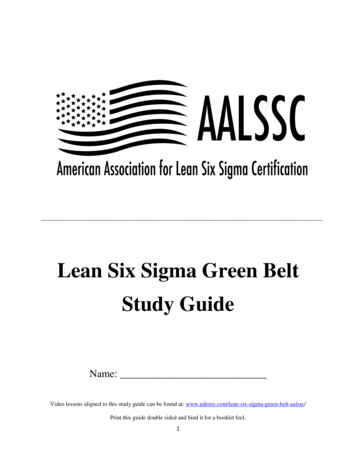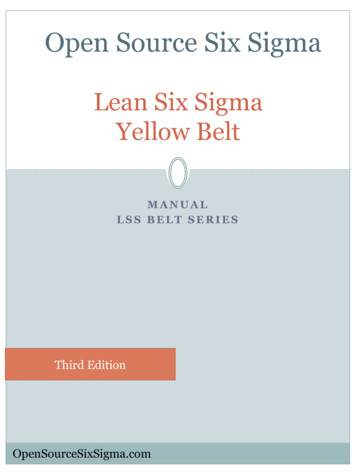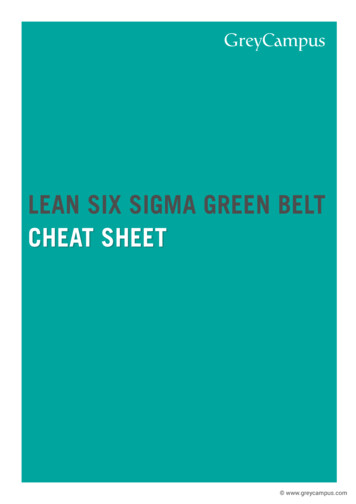
Transcription
International Journal of Scientific & Engineering Research, Volume 4, Issue 5, May-2013ISSN 2229-55181137Lean, six sigma and lean six sigmaOverviewAhmed MousaAbstract— Lean is an approach that seeks to improve flow in the value stream and eliminate waste. It’s about doing things quickly. SixSigma uses a powerful framework (DMAIC) and statistical tools to uncover root causes to understand and reduce variation. It’s about doingthings right (defect free).A combination of both provides an over-arching improvement philosophy that incorporates powerful data-driventools to solve problems and create rapid transformational improvement at lower cost.Index Terms— lean, six sigma, lean six sigma, TQM, JIT, DMAIC, PDCA, PDSA, VVFPP ,VSM,7 wastes,5S,SMED ,SPC—————————— ——————————T1LEAN AND SIX SIGMA OVERVIEWwo of the most popular continuous improvement programs are Six Sigma and lean management. Six Sigma wasfounded by Motorola Corporation and subsequentlyadopted by many US companies, including General ElectricalGE and Allied Signal. Lean management originated at Toyotain Japan and has been implemented by many major US firms,including Danaher Corporation and Harley-Davidson. SixSigma and lean management have diverse roots, (Arnheiterand Maleyeff, 2005).Six sigma and lean are new methods, or if they are repackaged versions of previously popular methods – total qualitymanagement (TQM) and just-in-time (JIT), (Naslund, 2008).The concept of lean management can be traced to the Toyota production system (TPS), a manufacturing philosophy pioneered by the Japanese engineers TaiichiOhno andShigeoShingo,(Arnheiter and Maleyeff,2005).Toyota Production System (TPS) is recognized with beingthe birthplace of just-in-time (JIT)production methods, a keyelement of lean production, and for this reason the TPS remains a model of excellence for supportive of lean management,(Arnheiter and Maleyeff,2005).IJSERBoth Six Sigma and lean management have evolved intocomprehensive management systems which clarify in lean sixsigma methodology. In each case, their effective implementation involves cultural changes in organizations, new approaches to production and to servicing customers, and a highdegree of training and education of employees, from uppermanagement to the shop floor. As such, both systems havecome to encompass common features, such as an emphasis oncustomer satisfaction, high quality, and comprehensive employee training and empowerment, (Arnheiter and Maleyeff,2005).Some elements to eliminate many misconceptions regarding Six Sigma and lean management by describing each system and the key concepts and techniques that underlie theirimplementation, (Arnheiter and Maleyeff, 2005).2 LEAN MANUFACTURING2.1 Lean DefinationLean defined as systematic approach to identifying andeliminating non value add (wastes) through continuous improvement, flowing the product at the pull of the customer inpursuit of perfection.(Andersson, et al 2006)“Lean production” term is a result of the benchmarking results from the IMVP. The word “lean” was suggested becausethe best assembly plants (the Japanese plants) (Womack et al.,1990, p. 13).(Dahlgaard, Park 2006),2.2 Lean OverviewTPS was the developed of manufacturing began shortly after the Second World War, pioneered by Taiichi Ohno andassociates, while employed by the Toyota motor company.Forced by shortages in both capital and resources, Eiji Toyodatrained his workers to eliminate all types waste (sevenwastes). Eiji defined the waste as “anything other than theminimum amount of equipment, materials, parts, space andtime which are absolutely essential to add value to the product” (Russell and Taylor, 2000, p. 737),(Pepper,Spedding,2010).The Toyota Production System (TPS) became the dominantproduction model to emerge froma number of conceptsaround at the time (Katayama and Bennett, 1996; Bartezzaghi,1999). As a result of the International Motor Vehicle Program(IMVP) benchmarking study, and the work of Womack et al.(1990), US and European companies began adapting the TPSunder the title of just-in-time (JIT) to remain competitive withJapanese industry.(Pepper,Spedding ,2010).Lean manufacturing is about controlling the resources in accordance with the customers’ needs and to reduce unnecessary waste ornon-value add (including the waste of time). The concept was introduced at a larger scale by Toyota in the 1950s, but not labeled leanmanufacturing until the now famous book about the automobile appeared in 1990.(Andersson, Eriksson and Torstensson, 2006).Lean manufacturing started in the form of the Toyota ProductionSystem has been around for decades, it did not get integrated withSix Sigma until the late 1990sand early 2000s (George, 2002, 2003).the approach in the areas where improvements could be identifiedand implemented quickly (one to four weeks), many of which in-IJSER 2013http://www.ijser.org
International Journal of Scientific & Engineering Research, Volume 4, Issue 5, May-2013ISSN 2229-55181138volved the flow of information and materials through a process. Today Lean Six Sigma is the improvement approach of choice. (Snee,2010).The “birth” of the term “lean production” The IMVP Researcher John Krafcik originally coined the term “lean production”. IMPV is an abbreviation of the International Motor Vehicle Program established at Massachusetts Institute of Technology in 1985. During the following 5 years, the IMVP staffcarried out the world’s most comprehensive benchmarkingstudy ever seen. The study collected data from automobileassembly plans all over the world in order to understand thedifferences in quality and productivity. The results of thisbenchmarking study were published in the well-known bookThe Machine that Changed the World (Womack et al., 1990),in which there is an exciting historical analysis of the machinecalled “the automobile(Dahlgaard ,Park 2006).2.3 Lean manufacturing ObjectivesThe lean production goal of eliminating waste (muda inJapanese), so that all activities along the value stream createvalue, is known as perfection efforts focused on the reductionof waste are pursued through continuous improvement orkaizen events, as well as radical improvement activities, orkaikaku. Both kaizen and kaikaku reduce muda, although theterm kaikaku is generally reserved for the initial rethinking ofa process. Hence, perfection is the goal and the journey to perfection is never ending,(Arnheiter and Maleyeff,2005).Fig.1Batch-and-queue versus lean quality systems2.4 lean benefitsThere are many reasons to launch lean techniques in an organization; asit may contribute substantially to eliminatingcosts and providing competitive advantages. Lean benefitsinclude reduced work-in-process (WIP), increased inventoryturns, increased capacity, cycle-time reduction and improvedcustomer satisfaction.(Andersson, et al 2006).IJSERQuality management practices in lean production emphasize the concept of zero quality control (ZQC). A ZQC systemincludes mistake proofing (poka-yoke), source inspection (operators checking their own work), automated 100 percent inspection, stopping operations instantly when a mistake ismade, and ensuring setup quality,(Arnheiter andMaleyeff,2005).The main objectives of lean is reduce the lead time of a process, one first analyses the customer’s demands of the processto identify the value (first V in roadmap). Hence, the objectivesof the improvement, besides reducing the lead time, are also toincrease customer satisfaction. In addition, increased productivity and an inventory reduction are common effects of successful lean projects.(Andersson, et al2006).Quality practices in batch-and-queue generally assure acceptance sampling performed by dedicated Quality inspectors,product quality audits, and statistical process control (SPC).Thus, for equivalent process levels of quality, poor quality inbatch-and-queue system would result in high external failurecosts, whereas poor quality in a lean production system wouldcause high internal failure costs and this is explained throughthe next Figure, (Arnheiter and Maleyeff,2005).Survey of 40 companies that had adopted lean manufacturing; typical improvements are visible in three areas. Theseimprovement areas include: operational improvements (reduction of lead time, increase in productivity, reduction inwork-in-process inventory, etc.), administrative improvements(reduction in order processing errors, streamlining of customer service functions so that customers are no longer placed onhold, etc.) and strategic improvements (reduced costs,etc.).(Andersson, et al 2006).2.5 Toyota Production System TPS and Seven WastesThe beginning of TPS and JIT as shows next, The ToyotaProduction System (TPS) provided the basis for what is nowknown as lean thinking, as popularized by Womack and Jones(1996). And the main target of lean thinking seven forms ofwaste have been identified(1) Over-production;(2) Defects;(3) Unnecessary inventory;(4) Inappropriate processing;(5) Excessive transportation;(6) Waiting; and(7) Unnecessary motion: (Pepper, Spedding, 2010)2.6 Lean and Value of the customerThe first step in a lean transition is to identify value-addedand non-value adding processes. The second step is Valuestream mapping (VSM) and the benefits of VSM are many,including the provision of a common language when considering manufacturing processes. It also brings together all ofthe lean techniques, which helps practitioners avoid the temptation to cherry-pick one or two of the “easier "to implement.IJSER 2013http://www.ijser.org
International Journal of Scientific & Engineering Research, Volume 4, Issue 5, May-2013ISSN 2229-5518In fact, no other tool illustrates the linkages between information and material flow like VSM (Rother and Shook, 1999).(Pepper, Spedding, 2010).VSM has its critics. suggested that the practical nature ofVSM (i.e. the paper and pencil approach) limits the amount ofdetail collected and also detracts from the actual system workings (the action of using pencil and paper to draw the mapmay remove focus from the actual system being analyzed).This dynamic view looks beyond VSM as giving a quick, succinct overview of where “muda” is present, and develops theidea of the mapping process itself becoming a continuous tool,constantly being updated via software such as I grafix, whenwe are using software can increase the data that can be represented compared to paper and pencil. (Pepper, Spedding,2010).VSM needs to be methodically applied before other toolssuch as single minute exchange of die (SMED) and 5S. Perhapsthe most widely used of the lean tools is 5S (concerned with acultural change in the organization, making systematic andstandardized processes normal routine, i.e. good housekeeping and not an exception).5S is seen as fundamental to achieving a lean business and is deemed equally also we can useVSM as powerful tool in lean six sigma methodology. (Pepper,Spedding, 2010)11392.8 Lean MisconceptionsThe misconceptions regarding lean management and sixsigma, the Lean productions was derived from the need toincrease product flow or decrease the production lead timethrough the elimination of all non-value-added activities andessential non value added activities . Six Sigma developedfrom the need to ensure final product quality by focusing onobtaining very high conformance at the OFD level. In order forproponents of one program to learn from the other program,some common misconceptions should be dispelled. The keymisconceptions are described below, (Arnheiter and Maleyeff,2005).The Key misconceptions regarding lean management infour points as below.1- Lean means layoffs Arnheiter and Maleyeff (2005) replayit is a misinterpretation of the term. In lean management, ifworkers were performing non-value-added activities withintheir job, management and the employee would work togetherto find a better way to perform the job to eliminate then onvalue-added activities. Laying-off the employee would becounterproductive since knowledgeable person would nolonger be available and the remaining employees would bedisinclined to take part in future waste elimination projects.Arnheiter and Maleyeff (2005)cited(Emiliani, 2001).to replayon the wrong lean meaning, layoffs cannot take place in thecontext of lean management, unless it becomes an absolutenecessity and every effort to re-assign or re-train the employeefails2-Lean only works in Japan, because of their unique cultureIn fact, lean management is not a universalsystem in Japanand some of the most successful lean management implementations have been within non-Japanese companies Arnheiterand Maleyeff (2005) cited(Emiliani, 2003). The source of themisconception may be the belief that Japanese workers are bynature more frugal than their international counterparts. Evenif this statement were true, eliminating waste and being frugaloften conflict, such as when an engineer designs an inferiorpart to save money.IJSER2.7 Lean Manufacturing RoadmapThe lean principles are fundamentally customer value driven, which makes them appropriate for many manufacturingand distribution situations. Five basic principles of lean manufacturing are generally acknowledged and the lean roadmapcalled VVFPP as per clarify next:(1) Understanding customer value (V). Only what the customers perceive as value is important and value meaning theneeds and requirements.(2) Value stream analysis (V). Having understood the valuefor the customers, the next step is to analyze the business processes to determine which ones actually add value. If an actiondoes not add value, it should be modified or eliminated fromthe process. The VSM phase is important phase to determinethe value adds and non value add and business value add ineach process.(3) Flow (F). Focus on organizing a continuous flowthrough the production or supplychain rather than movingcommodities in large batches, in this phase we change the process to one piece flow to eliminate the wastes and work inprocess (WIP).(4) Pull. (P) Demand chain management prevents fromproducing commodities to stock, i.e. customer demand pullsfinished products through the system. No work is carried outunless the result of it is required downstream.(5) Perfection. (P) The elimination of non-value-adding elements (waste) is a process of continuous improvement (CIP).“There is no end to reducing time, cost, space, mistakes, andeffort”. (Andersson, et al 2006).3- Lean for manufacturing only Arnheiter and Maleyeff(2005) replay lean management views each step in the processas a service step, where customer value is added with minimalwaste. Within this framework, processing claims in the insurance industry, evaluating loan applications at a bank, andtreating patients in a hospital all involve performing activitiessynonymous with the lean management viewpoint. In anybusiness where customers Batch-and-queue versus lean quality systems exist and activities take place to satisfy those customers, lean management can be practiced successfully.4- Lean only works within certain environments Arnheiterand Maleyeff (2005) replay this view is heard from managersin operations that are traditionally large batch operations aswell as from managers of diverse job-shop operations. Whilethese types of operations may never conform to the “lot size ofone” principle, lean management encompasses much moreIJSER 2013http://www.ijser.org
International Journal of Scientific & Engineering Research, Volume 4, Issue 5, May-2013ISSN 2229-5518than manufacturing process design. If attempts were made toidentify and eliminate all non-value-added activities throughout the organization, these companies would be practicingimportant aspects of lean management. These companiescould also pursue other elements of lean management, by continuously attempting to follow lean principles when adoptingnew manufacturing technologies (Arnheiter and Maleyeff,2005).2.9 Criticism of leanThe main criticism against lean is the lack of flexibility the concept offers, see Dove (1999), and that the concept actually canlead to delays for the customers, see Cushman (1994). There isalso a discussion going on whether lean, which was developedfor manufacturing and distribution situations, is applicable inall industries. Mast (2004).(Andersson, et al 2006).There are two points which was considered as weak pointsin lean methodology (criticism) the two points shows below:1The lean organization may become very susceptible tothe impact of changes. The leanness in itself leads to reducedflexibility and less ability to react to new conditions and circumstances (Dove, 1999).2JIT deliveries cause congestion in the supply chain,leading to delays, pollution, shortage of workers, etc. (Cushman, 1994).(Andersson, et al 2006).To overcome this, thelean approach must integrate the useof targeted data to make decisions and also adopt a more scientific approach to quality within the system. (Pepper,Spedding, 2010)of process variation, about 99.7 percent of the components fora centered process would be expected to conform to tolerances. That is, only 0.3 percent of parts would be nonconformingto tolerances, which means that to3,000 defected parts per million (DPPM),(Arnheiter and Maleyeff,2005).The six sigma started by Motorola was the first company tolaunch a six sigma approach in the mid-1980sIn 1988, wherethe Motorola specialized in electronic products, Bill Smith1986is engineer and statistician at Motorola, introduce the six sigma concept aiming to attack the existing quality problems inthe company.Motorola received the Malcolm Baldrige National QualityAward, which led to an increased interest of six sigma in otherorganizations, see Pyzdek (2001). Today, a number of globalorganizations have developed six sigma approach of theirown and six sigma is now established in almost every industry. (Andersson, et al 2006).At Motorola, when studying the relationship between thequality of component and the quality of finalproduct it wasdiscovered that, from lot-to-lot, a process tended to shiftamaximum of 1.5 sigma units (McFadden, 1993). This conceptis shown graphically in next Figure, which shows a centeredprocess and processes, shifted 1.5 sigma units in bothdirections. Table provides the relationship between componentquality and finalproduct quality, assuming that the full 1.5sigma shift takes place. In next Table, Sigmalevel is the standardized process variation (see Figure), OFD quality is theNCPPM ifthe process shifts a full 1.5 sigma units, and theprobabilities in the table provide theproportion of final products that will be free of defects. For example, if the companysets a goal for final product quality of 99.7 percent and products include about 1,000 OFDs, then the 3.4 DPPM corresponding to the Six-Sigma methodology would became thestandard against which all decisions were made,(Arnheiterand Maleyeff,2005).IJSER3 SIX SIGMA METHODOLOGY3.1 Six sigma Definition1140The six sigma define as business process that allows companies to drastically improve their bottom line by designingand monitoring everyday business activities in ways that minimize waste and resources while increasing customer satisfaction by some of its proponents.(Andersson, et al 2006).The term “Six Sigma” refers to a statistical measure of defect rate within a system. supported by statistical techniques, itpresents a structured and systematic approach to process improvement, aiming for a reduced defect rate of 3.4 defects dding,2010)3.2 Six sigma History and OverviewThe six-sigma methodology was developed at Motorola in1987 in response to sub-standard product quality traced inmany cases to decisions made by engineers when designingcomponent parts. Traditionally, design engineers used the“three-sigma” rule when evaluating whether or not an acceptable proportion of manufactured components would besupposed to meet tolerances. When a component’s toleranceswere consistent with a spread of si
GE and Allied Signal. Lean management originated at Toyota in Japan and has been implemented by many major US firms, including Danaher Corporation and Harley-Davidson. Six Sigma and lean management have diverse roots, (Arnheiter and Maleyeff, 2005). S




